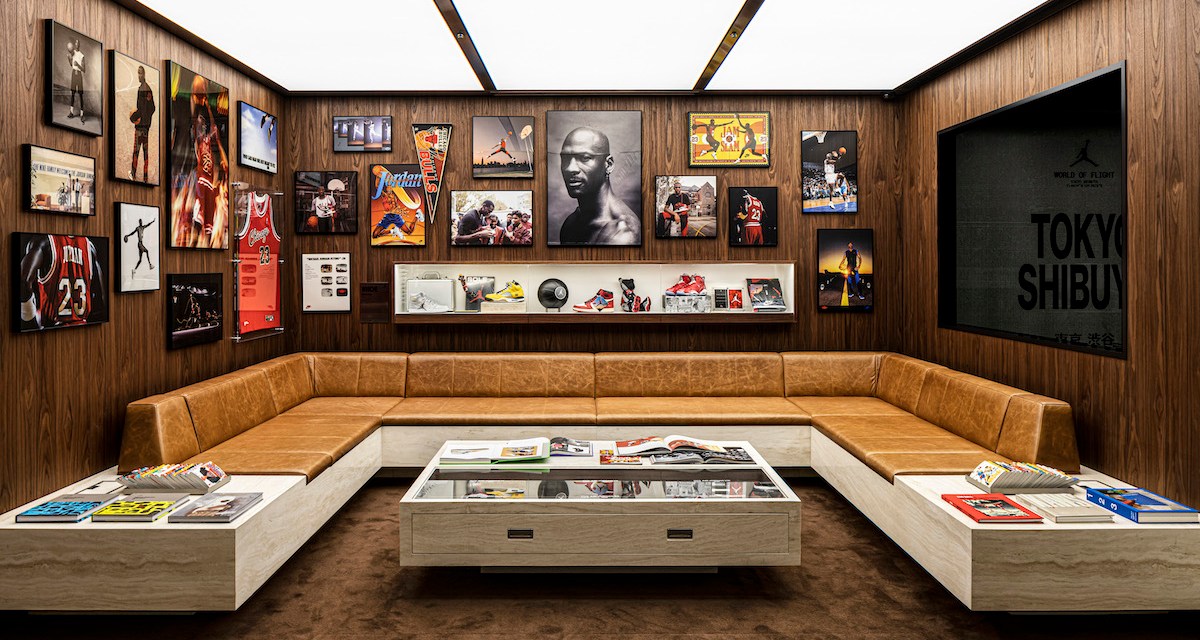To grow its DTC business, Nike is opening stores for Jordan Brand

As part of its plan to grow sales from DTC channels, Nike is increasingly building stores for some of its most notable brands.
This past weekend, Nike opened its first Jordan Brand-only store in Japan, Jordan World of Flight Shibuya. The store, which Nike calls “the pinnacle of Jordan Brand culture at retail,” includes wall-to-wall displays of Jordan Brand products, a customization station, pick-up services and a content creation studio. Its launch comes just months after Nike debuted a similar concept store, Jordan World of Flight Milan, in Italy last December.
Nike has traditionally leaned on several channels, including wholesale and marketplaces, for revenue. Over the past few years, however, it’s started funneling more resources to its stores, website and app to better control inventory and keep a larger portion of sales. In 2017, Nike announced it would narrow its focus to just 40 select retail partners, and last year, it cut ties to major retailers such as DSW and Urban Outfitters. Building new stores for Nike’s owned brands, which come with their own built-in followings, is just one more way Nike can drive growth directly to the company — especially as physical retail sees a boost. Outside of its Jordan Brand stores, Nike has Converse flagships in Boston and New York City, as well as dozens of Converse outlet locations across 28 U.S. states.
As it looks to build up its DTC business, Nike has experimented with different store formats. Nike Live, which it piloted in 2018, is smaller and more neighborhood-driven. Nike Rise, which it piloted in 2020, is also locally-focused, but to a bigger scale and with more data and in-store events. Last summer, Nike introduced Nike Style, which features a gender-agnostic product section and a content studio, according to the company. Nike also has three House of Innovation stores in Shanghai, New York and Paris. These have massive footprints and tower several levels high.
Brad Jashinsky, director analyst at Gartner, told Modern Retail that Nike has done “a really nice job” of “really focusing stores on different audiences.” He continued, “Of course, the bread and butter is just the overall Nike store.” But he added that the strategy of tailoring product assortment and events based on what is popular in a particular city “allows them to tell a story more about those specific products and connect more with that consumer.”
Over the years, Nike has also acquired an enormous amount of customer data through these different stores. Now, when building stores for one specific brand, it can use that data to decide where to plant its flag next, Rebekah Kondrat, founder of Rekon Retail, told Modern Retail. Nike’s thinking is likely, “We want to essentially go not only where our customers are, but also get very specific about the inventory that we’re putting out to that customer to give the store a higher likelihood to succeed,” she explained.
But that inventory has also been a major headache for Nike over the past several quarters. While it has managed to make substantial progress on how much product it has, Nike still had $8.9 billion in inventory as of last quarter, a 16% jump from the same time last year.
Ad position: web_incontent_pos1
Still, building new stores just for Jordan Brand could be huge for Nike’s bottom line. Since its founding in the 1990s, the brand has “taken on a life of its own,” Jashinsky said. Last year, Nike revealed that Jordan Brand made $5.1 billion in annual revenue for fiscal 2022. In an earnings call earlier this month, Nike EVP Matt Friend said Jordan Brand had “strong double-digit growth” and “incredible momentum.” The brand has particularly grown among women, and has “even greater potential, with a path toward becoming the number two footwear brand in North America,” he added.
Nike’s newest Jordan Brand store measures 9,200 square feet and has a dedicated area for customers to pick up shoes they purchased on the app, as well as an area where members can “test new offerings and experiences,” according to the company. There is also the Flight Lounge, which pays homage to Michael Jordan, as well as the Content Studio, where shoppers can film unboxings and reviews to post on their social channels. In the same vein as Nike’s other localized concepts, World of Flight Shibuya features the work of local artists.
Taking stock of the larger footwear landscape, now is the perfect time to build Jordan Brand stores, Kondrat said. Nike’s rival Adidas has issued several recent profit warnings, struggled with its celebrity partnerships and remains stuck with hundreds of millions of dollars of unsold Yeezy merchandise. “There’s this opening with the street and sneaker sector,” Kondrat said. “You now have this gap in the market.”
Nike isn’t the only major footwear retailer to start opening physical stores for its owned brands. Deckers, the parent company of Hoka One One and Ugg, operates multiple stores for each brand across the U.S. The move is paying off. Deckers said 52% of its third-quarter sales came through DTC, its highest share ever.

